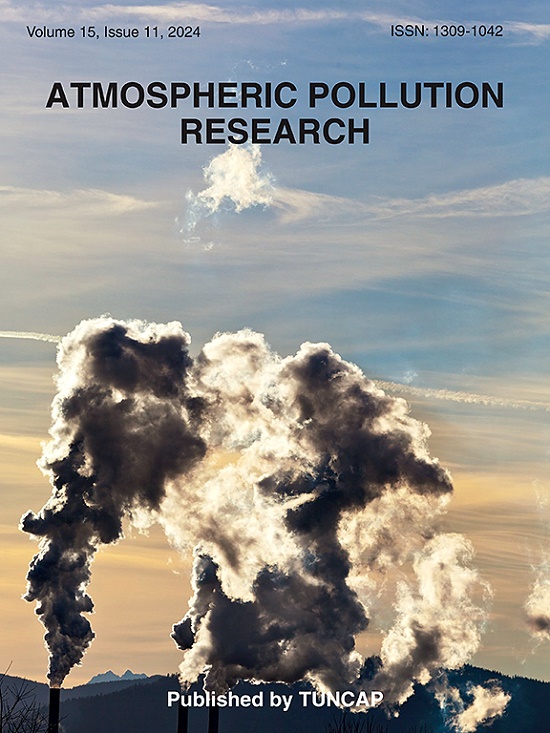Effects of the southwest vortex on the vertical structure of ozone in the Sichuan Basin in China
IF 3.5
3区 环境科学与生态学
Q2 ENVIRONMENTAL SCIENCES
引用次数: 0
Abstract
To investigate the mechanism by which the southwest vortex (SWV) affected the vertical distribution of O3 in the lower troposphere over the Sichuan Basin (SCB), the SWV cases from April to September of each year from 2015 to 2018, the concentrations of O3 in the same periods, meteorological factors (such as temperature, humidity, and wind), and the convective stability index were analysed. The results revealed 78 dry SWVs, 74 weak precipitation SWVs, and 37 heavy precipitation SWVs over the SCB. The dry SWV increased the mean O3 column concentration (MOCC) over the SCB (+1.75 %), and the precipitation SWVs reduced the MOCC, with the weak precipitation SWVs (−7.44 %) having a greater reduction than the heavy precipitation SWVs (−5.42 %). Furthermore, the O3 concentrations at various altitude layers were impacted to varied degrees, with the strongest scavenging effect occurring at the 850 hPa layer. The scavenging effect was especially significant in areas with high O3 concentrations, such as the Chengdu Plain. The transit of precipitation SWVs resulted in the cooling and humidification of all layers, which could have suppressed O3 photochemical reactions and reduced the O3 concentration, whereas the dry layer during the transit of dry SWVs increased the O3 concentration at the bottom of the basin. In terms of the different dispersion situations, Chongqing was dominated by horizontal winds during the transit of SWVs. However, the wind speed in the central and western SCBs was greater and the vertical component of the wind was stronger, which was favourable for O3 dispersion in Chengdu.
西南涡旋对四川盆地臭氧垂直结构的影响
为探讨西南涡旋(SWV)对四川盆地对流层低层O3垂直分布的影响机制,分析了2015 - 2018年每年4 - 9月西南涡旋(SWV)对四川盆地对流层低层O3垂直分布的影响,分析了同期的O3浓度、气象因子(温度、湿度、风)和对流稳定指数。结果表明,在华南地区有78个干旱swv、74个弱降水swv和37个强降水swv。干燥SWV使SCB上的平均O3柱浓度(MOCC)增加(+ 1.75%),降水SWV使MOCC降低,弱降水SWV(- 7.44%)比强降水SWV(- 5.42%)的降低幅度更大。不同海拔层的O3浓度受到不同程度的影响,其中850 hPa层的清除作用最强。在臭氧浓度较高的地区,如成都平原,其清除效果尤为显著。降水swv的过境导致各层的冷却和加湿,这可能抑制了O3光化学反应并降低了O3浓度,而干燥swv过境期间的干燥层则增加了盆地底部的O3浓度。从不同的分散情况来看,重庆在swv过境过程中以水平风为主。而中部和西部SCBs的风速较大,垂直分量较强,有利于O3在成都的扩散。
本文章由计算机程序翻译,如有差异,请以英文原文为准。
求助全文
约1分钟内获得全文
求助全文
来源期刊

Atmospheric Pollution Research
ENVIRONMENTAL SCIENCES-
CiteScore
8.30
自引率
6.70%
发文量
256
审稿时长
36 days
期刊介绍:
Atmospheric Pollution Research (APR) is an international journal designed for the publication of articles on air pollution. Papers should present novel experimental results, theory and modeling of air pollution on local, regional, or global scales. Areas covered are research on inorganic, organic, and persistent organic air pollutants, air quality monitoring, air quality management, atmospheric dispersion and transport, air-surface (soil, water, and vegetation) exchange of pollutants, dry and wet deposition, indoor air quality, exposure assessment, health effects, satellite measurements, natural emissions, atmospheric chemistry, greenhouse gases, and effects on climate change.
 求助内容:
求助内容: 应助结果提醒方式:
应助结果提醒方式:


